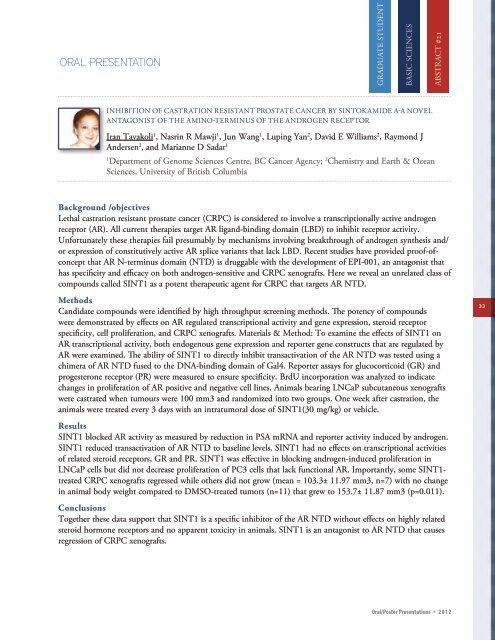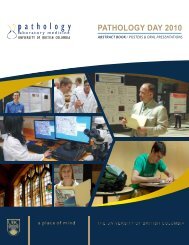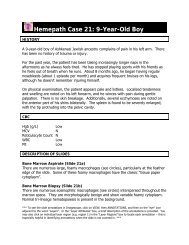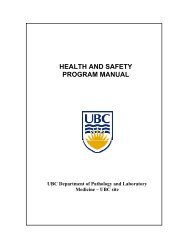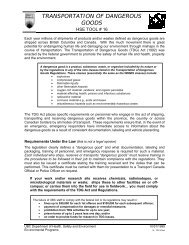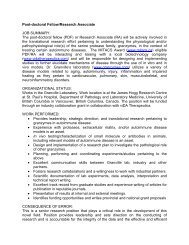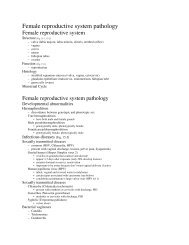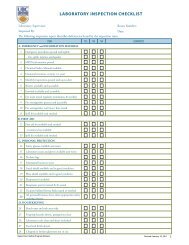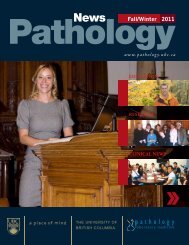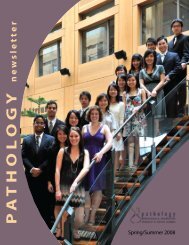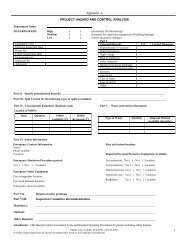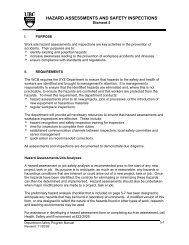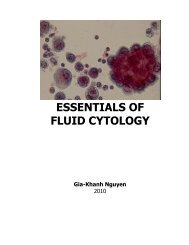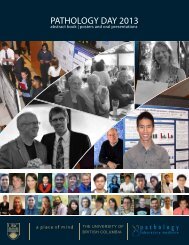Abstract Book - Pathology and Laboratory Medicine - University of ...
Abstract Book - Pathology and Laboratory Medicine - University of ...
Abstract Book - Pathology and Laboratory Medicine - University of ...
You also want an ePaper? Increase the reach of your titles
YUMPU automatically turns print PDFs into web optimized ePapers that Google loves.
oral presentationGRADUATE STUDENTBASIC SCIENCESABSTRACT #21Inhibition <strong>of</strong> castration resistant prostate cancer by sintokamide A-a novelantagonist <strong>of</strong> the amino-terminus <strong>of</strong> the <strong>and</strong>rogen receptorIran Tavakoli 1 , Nasrin R Mawji 1 , Jun Wang 1 , Luping Yan 2 , David E Williams 2 , Raymond JAndersen 2 , <strong>and</strong> Marianne D Sadar 11Department <strong>of</strong> Genome Sciences Centre, BC Cancer Agency; 2 Chemistry <strong>and</strong> Earth & OceanSciences, <strong>University</strong> <strong>of</strong> British ColumbiaBackground /objectivesLethal castration resistant prostate cancer (CRPC) is considered to involve a transcriptionally active <strong>and</strong>rogenreceptor (AR). All current therapies target AR lig<strong>and</strong>-binding domain (LBD) to inhibit receptor activity.Unfortunately these therapies fail presumably by mechanisms involving breakthrough <strong>of</strong> <strong>and</strong>rogen synthesis <strong>and</strong>/or expression <strong>of</strong> constitutively active AR splice variants that lack LBD. Recent studies have provided pro<strong>of</strong>-<strong>of</strong>conceptthat AR N-terminus domain (NTD) is druggable with the development <strong>of</strong> EPI-001, an antagonist thathas specificity <strong>and</strong> efficacy on both <strong>and</strong>rogen-sensitive <strong>and</strong> CRPC xenografts. Here we reveal an unrelated class <strong>of</strong>compounds called SINT1 as a potent therapeutic agent for CRPC that targets AR NTD.MethodsC<strong>and</strong>idate compounds were identified by high throughput screening methods. The potency <strong>of</strong> compoundswere demonstrated by effects on AR regulated transcriptional activity <strong>and</strong> gene expression, steroid receptorspecificity, cell proliferation, <strong>and</strong> CRPC xenografts. Materials & Method: To examine the effects <strong>of</strong> SINT1 onAR transcriptional activity, both endogenous gene expression <strong>and</strong> reporter gene constructs that are regulated byAR were examined. The ability <strong>of</strong> SINT1 to directly inhibit transactivation <strong>of</strong> the AR NTD was tested using achimera <strong>of</strong> AR NTD fused to the DNA-binding domain <strong>of</strong> Gal4. Reporter assays for glucocorticoid (GR) <strong>and</strong>progesterone receptor (PR) were measured to ensure specificity. BrdU incorporation was analyzed to indicatechanges in proliferation <strong>of</strong> AR positive <strong>and</strong> negative cell lines. Animals bearing LNCaP subcutaneous xenograftswere castrated when tumours were 100 mm3 <strong>and</strong> r<strong>and</strong>omized into two groups. One week after castration, theanimals were treated every 3 days with an intratumoral dose <strong>of</strong> SINT1(30 mg/kg) or vehicle.ResultsSINT1 blocked AR activity as measured by reduction in PSA mRNA <strong>and</strong> reporter activity induced by <strong>and</strong>rogen.SINT1 reduced transactivation <strong>of</strong> AR NTD to baseline levels. SINT1 had no effects on transcriptional activities<strong>of</strong> related steroid receptors, GR <strong>and</strong> PR. SINT1 was effective in blocking <strong>and</strong>rogen-induced proliferation inLNCaP cells but did not decrease proliferation <strong>of</strong> PC3 cells that lack functional AR. Importantly, some SINT1-treated CRPC xenografts regressed while others did not grow (mean = 103.3± 11.97 mm3, n=7) with no changein animal body weight compared to DMSO-treated tumors (n=11) that grew to 153.7± 11.87 mm3 (p=0.011).ConclusionsTogether these data support that SINT1 is a specific inhibitor <strong>of</strong> the AR NTD without effects on highly relatedsteroid hormone receptors <strong>and</strong> no apparent toxicity in animals. SINT1 is an antagonist to AR NTD that causesregression <strong>of</strong> CRPC xenografts.Oral/Poster Presentations * 2012 33


